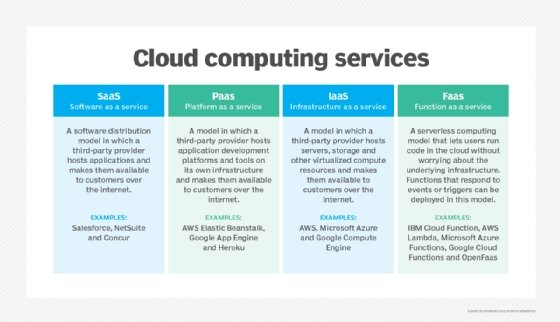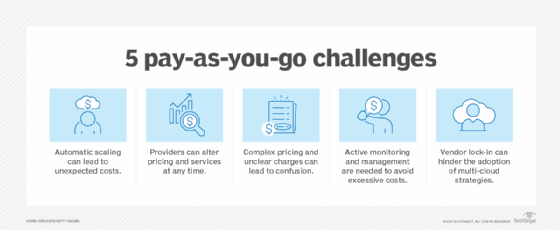
What is pay-as-you-go cloud computing (PAYG cloud computing)?
Pay-as-you-go cloud computing, or PAYG cloud computing, is a payment method for cloud computing that charges based on usage. The practice is similar to that of utility bills, using only resources that are needed.
One major benefit of the pay-as-you-go model, which is a form of consumption-based or usage-based pricing, is that there are no wasted resources. Users only pay for what they use, such as the amount of bandwidth consumed, rather than a certain amount of resources that might or might not be used. With traditional enterprise design, users architect data storage to handle the maximum workload. But with the public cloud, the pay-as-you-go method charges the organization only for what it stores, provisions or uses.
Pay-as-you-go platforms, such as Amazon Elastic Compute Cloud, provide services by letting users design compute resources and charge by what's used. Users select the CPU, memory, storage, operating system, security, networking capacity, access controls and additional software needed to run their environment.
There are four main categories of cloud computing services, each using a different form of the pay-as-you-go model:
- Software as a service. SaaS pricing can be based on features, storage capacity or a per-user basis. Examples include Microsoft Dynamics 365, Oracle, NetSuite and Salesforce.
- Platform as a service. PaaS resources can be priced per application, user or gigabyte of memory consumed per hour. Microsoft offers a per-minute pricing model for its PaaS that stops the meter when an organization discontinues using a virtual machine (VM) but preserves the VM state and configuration. PaaS examples include Google, Microsoft Windows Azure and Oracle Cloud.
- Infrastructure as a service. With IaaS, customers pay on a per-use basis, typically by the hour, week or month. Some cloud providers also charge based on the amount of VM space used. This model doesn't require users to deploy in-house hardware and software. IaaS vendors include Amazon Web Services (AWS), IBM, Hewlett-Packard and Microsoft.
- Function as a service. This serverless computing model is often used to deploy microservices and offers users a convenient way to build cloud applications that respond to discrete events. Customers are billed for the FaaS model based on only the functionality used during processing. FaaS vendors include AWS Lambda, IBM, Netlify and Oracle.

Characteristics of a PAYG model
The PAYG model is ideal for businesses with fluctuating workloads, varying usage patterns or those wanting to avoid fixed contract commitments. This on-demand pricing structure also enables startups and Fortune 500 companies to innovate and scale quickly without large upfront costs or long-term obligations.
The main characteristics of a PAYG model include the following:
- On-demand resources. The PAYG model offers on-demand, self-service resource provisioning, enabling users to quickly scale resources based on demand through automation without manual intervention from the cloud provider. Additionally, no upfront hardware or software investments are required, further streamlining the resource provisioning process.
- Metered billing. Instead of a fixed fee, users are charged based on actual resource consumption, such as storage, computing power and data transfer. This approach helps organizations achieve more accurate budgeting and cost management.
- Resource pooling. Most cloud providers consolidate server and computing resources to serve multiple customers using the same physical infrastructure. Resources are dynamically allocated and adjusted according to customer demand or business needs.
- Transparent pricing. The PAYG model typically offers straightforward pricing structures, making it easy for users to understand and optimize costs as well as make informed decisions about resource usage.
Benefits of pay-as-you-go cloud computing
Traditional data center and colocation computing rely heavily on static resources. Engineers must plan and execute the computing, storage and other resources anticipated to support peak workload demand. This can often lead to costly overallocation with far more resources procured and deployed than are needed.
PAYG cloud computing offers the following benefits and use cases that favor dynamic cloud environments:
- Ease of use. A cloud architect or engineer can adjust resources with a few clicks or configure some resources to adjust automatically as workload demands change in real-time. This ease has played a major role in cloud adoption as both a supplement to local, or traditional, computing and cloud-first infrastructures.
- High scalability. Cloud providers can deliver enormous quantities of resources to drive almost any size workload or computing demand, such as big data analytics and other projects. Those resources can be released when work is complete or demands change.
- Right-sizing resources. The challenges of traditional computing infrastructure led to enormous waste due to over-provisioning. PAYG cloud computing makes it easy to adjust resources to meet user demands, minimizing overprovisioning.
- Cost-efficient. The combination of ease, scalability and support for dynamic situations can potentially make PAYG cloud computing more cost-efficient than traditional data center computing, though cost savings aren't guaranteed.
- Advanced security. Cloud service providers invest heavily in security measures, offering features such as encryption, multifactor authentication, and advanced threat detection to protect data and applications as well as provide strong disaster recovery capabilities. Additionally, most cloud providers have dedicated security teams to ensure continuous resource monitoring and compliance with industry standards.
Drawbacks of pay-as-you-go cloud computing
Despite its advantages, PAYG cloud computing also has a variety of disadvantages that cloud architects and engineers should consider closely when planning a workload deployment in the public cloud:
- Planning challenges. A traditional data center computing model forces businesses to watch usage closely and plan for increased capacity well in advance. With PAYG cloud computing, architects and engineers tend to be more reactive by manually adjusting cloud resources or configuring automatic real-time changes. This puts the burden on businesses to set up and assess cloud utilization to ensure cloud usage maps with business plans and goals.
- Unpredictable costs. The dynamic and often automatic nature of cloud scalability means that businesses might not even be aware of the resource scaling taking place until the monthly bill arrives. The result is uneven and unpredictable costs. Unpredictable costs can complicate cloud workload budgeting at best. At worst, it can cause price crunches that might affect a business's ability to operate a cloud workload affordably. It's important to consider and set up scalability guardrails and alerts when planning a cloud deployment.
- Changing rules. Cloud providers can change prices, set utilization limits and make other changes to their resources and cloud services over time. Any changes can affect an organization's ability to operate in a PAYG environment.
- Complex pricing structure. Some PAYG models feature complex pricing structures that can make it difficult for users to understand how charges are calculated, potentially leading to confusion and dissatisfaction, especially if they're unaware of how their actual usage affects costs.
- Resource management challenges. With the PAYG model, users must actively manage and monitor their usage to avoid excessive costs, which could require companies to invest in additional metrics, tools or expertise.
- Vendor lock-ins. As businesses become reliant on a specific cloud provider's IT infrastructure, services and tools, migrating to another provider can become complex and costly. This dependence on a single vendor can limit flexibility and create challenges for the business if it wants to switch providers or adopt a multi-cloud strategy in the future.
- Less control over service outages. The PAYG model relies on the service providers for software maintenance, provisioning and overall infrastructure management. If there are network connectivity issues or service outages, users can temporarily lose access to the service.

Types of PAYG cloud payment models
In general terms, all cloud computing is PAYG. Users might need to parse several possible payment models, depending on the provider and the services. Understanding the potential variations in the payment model can be important for reviewing and analyzing cloud computing costs over time.
The following are the main types of PAYG payment models:
- Subscription-based payment model. A subscription is typically the most familiar and traditional PAYG payment model. Access to a product or service is procured through a fixed, recurring cost, such as per user per month. PaaS and SaaS offerings frequently use a subscription model such as cloud storage or Office 365. Subscriptions are easy to understand, but they're often underutilized. For example, an Office 365 subscription might enable continuous access to the Office suite for a fixed cost, but no human uses that SaaS 24/7 year-round. If a typical employee uses their Office subscription for an average of four hours each day, the rest of that subscription time is wasted.
- Pay-as-you-go payment model. This is the most common PAYG model where users pay only for the resources that are provisioned and operational. For example, if a cloud user provisions a VM instance, users pay for that VM each month for the duration of that allocation. The user stops paying for that resource once it's relinquished. However, this model doesn't consider utilization -- it doesn't matter whether the business is actually running anything on those allocated resources.
- Pay-as-you-use payment model. This pay-per-use pricing model is a recent expression of PAYG where cloud users pay only for the resources that are used or performing actual work. FaaS is a popular example of this model. Users pay for the function resources, such as servers and storage, only while the function is executing, often to the closest second or fraction of a second. A popular variation of this model is pay-per-call, where users are charged a fee each time a service is invoked, such as application programming interface costs per call.
- Tiered pricing. Users are charged based on predefined tiers of usage, each with a set price and offering a specific level of service or resource allocation. As users exceed the limits of a lower tier, they move to a higher tier with increased costs. For example, a cloud storage service might charge $10 for up to 100 GB, $20 for 101-500 GB and $30 for 501-1000 GB.
- Flat rate pricing with usage caps. Users pay a flat fee for a base level of service, with additional charges applied if they exceed specific usage limits. This model blends aspects of subscription and PAYG. For example, a software service might charge $50 monthly for up to 100 transactions, with an extra fee for each transaction beyond that threshold.
- Spot instances. With spot instances, users can bid on and access unused computing capacity from the cloud provider at much lower costs. These instances are ideal for fault-tolerant and flexible workloads as they can be reclaimed at short notice when the demand increases.
Payment models aren't mutually exclusive. A cloud provider might offer services that involve all these models. In addition, a cloud service can have multiple payment models, such as subscription and per-use fees. When architecting a cloud infrastructure for business applications, cloud engineers must have a clear understanding of each resource and service cost structure. Ongoing cost tracking and analysis are crucial to cost-effective PAYG usage.
Cloud computing is the ideal platform for building and deploying modern applications. Discover its key characteristics, including scalability, flexibility, multi-tenant architecture and on-demand resource access.






